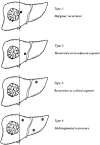Significance of resection margin in hepatectomy for hepatocellular carcinoma: A critical reappraisal
- PMID: 10749616
- PMCID: PMC1421031
- DOI: 10.1097/00000658-200004000-00014
Significance of resection margin in hepatectomy for hepatocellular carcinoma: A critical reappraisal
Abstract
Objective: To evaluate the influence of the width and histologic involvement of the resection margin on postoperative recurrence after resection of hepatocellular carcinoma (HCC).
Summary background data: The significance of the resection margin in hepatectomy for HCC remains controversial. A precise evaluation of the effects of the width and histologic involvement of the resection margin on postoperative recurrence is required to clarify the issue.
Methods: Two hundred eighty-eight patients with macroscopically complete resection of HCC were divided into groups with narrow (<1 cm) or wide (>/=1 cm) resection margins. The two groups were compared for postoperative recurrence rate and pattern of recurrence. A further analysis was performed to investigate the effects of histologic involvement of the resection margin on postoperative recurrence.
Results: Recurrence rates were similar between 150 patients with a narrow margin and 138 patients with a wide margin; the groups were comparable in other clinicopathologic variables. Most recurrent tumors occurred in the liver remnant at a segment distant from the resection margin or at multiple segments. Thirty-four patients had margin involved histologically by microscopic invasion from the main tumor (n = 13), venous tumor thrombi (n = 13), or microsatellites separate from the main tumor (n = 8). These patients had significantly higher recurrence rates than those with a histologically clear margin. However, a positive histologic margin was not a significant risk factor for recurrence by multivariate analysis. Tumor stage and perioperative transfusion were the only independent risk factors.
Conclusions: The width of the resection margin did not influence the postoperative recurrence rates after hepatectomy for HCC. A positive histologic margin was associated with a higher incidence of postoperative recurrence, but in most patients this was related to the underlying venous invasion or microsatellites. Most intrahepatic recurrences were considered to arise from intrahepatic metastasis by means of venous dissemination, which a wide resection margin could not prevent.
Figures



References
-
- Nagasue N, Uchida M, Makino Y, et al. Incidence and factors associated with intrahepatic recurrence following resection of hepatocellular carcinoma. Gastroenterology 1993; 105:488–494. - PubMed
-
- Lee CS, Sung JL, Hwang LY, et al. Surgical treatment of 109 patients with symptomatic and asymptomatic hepatocellular carcinoma. Surgery 1986; 99:481–490. - PubMed
-
- The Liver Cancer Study Group of Japan. Predictive factors for long-term prognosis after partial hepatectomy for patients with hepatocellular carcinoma in Japan. Cancer 1994; 74:2772–2780. - PubMed
-
- Chen MF, Hwang TL, Jeng LB, et al. Postoperative recurrence of hepatocellular carcinoma: two hundred five consecutive patients who underwent hepatic resection in 15 years. Arch Surg 1994; 129:738–742. - PubMed
MeSH terms
LinkOut - more resources
Full Text Sources
Medical

